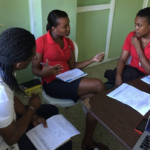To put the challenge of violence against transgender (trans) women in perspective, consider this estimate: the Inter-American Commission for Human Rights reports that in Latin America and the Caribbean (LAC), a trans woman’s life expectancy is 30 to 35 years.
Reviews of the research in LAC and other regions in 2009 and 2016 found that the gender-based violence (GBV) trans women experience makes them more vulnerable to a range of mental and physical health problems, including depression, low self-esteem, suicide, sexually transmitted infections (STIs), and STI-related cancers. Globally, trans women are 49 times more likely to acquire HIV compared to other adults.
In this post, we take a closer look at a new paper that seeks to fill some of those gaps in our understanding of violence against trans women in the LAC region. Part of a broader study of GBV against key populations conducted by the United Nations Development Programme (UNDP) and LINKAGES with local partners, this research examined violence against trans women in many contexts. Here we describe the paper’s methodology and the findings on GBV in health care and from police.
A participatory approach
Our team of researchers from UNDP, LINKAGES and the University of the West Indies conducted the study with local organizations providing services to trans women in cities in Barbados, El Salvador, Haiti, and Trinidad and Tobago. Given the sensitivity of the topic and how marginalized trans women are, a participatory approach was essential to the success of this research.
Perhaps most important, trans women recruited and interviewed the study participants. After receiving training in qualitative research, interviewing skills, study procedures and research ethics, 12 trans women used a structured interview guide to conduct interviews with 74 participants, asking both open- and close-ended questions about experiences with GBV. They also asked participants to discuss any positive interactions they had had with service providers.
Findings
The research results provide insights into the types of violence trans women experience and how GBV prevents them from realizing their health and human rights. In this post, we focus on reported violence perpetrated by health care providers and police officers. The full findings, including descriptions of violence that trans women experienced in other contexts, are described in detail in the paper.
Violence in health care: Almost 83 percent of the study participants had experienced some form of GBV in health care settings. The most common type of GBV was emotional abuse, including insults, harassment, threats and exclusion.
Participants described receiving substandard or neglectful care or being denied care, directly or indirectly. Some health care staff told participants to seek services elsewhere because they were “different,” while others said they were unable to find a patient’s medical records or switched the patient to a different doctor without explanation.
Only the Haitian participants reported experiencing physical abuse in health care settings, but almost one-quarter of participants in all four countries said they had been threatened with physical violence. In one of the most alarming examples, a provider in Haiti told a patient, “Damn it, if I knew you were that type of person, I’d take a shot and kill you, because I don’t like people like you.’’
Because of the discrimination and abuse they experienced, trans women often left clinics without being treated or avoided health care services. “There are times when they take away your motivation, even just to visit health centers, because they don’t respect you,” explained a participant from El Salvador.
Violence from police: Four out of five study participants had experienced GBV in encounters with police. As in health care settings, the most common type of violence was emotional, including stigmatizing or insulting comments and blaming trans women for the violence perpetrated against them.
The types of GBV the participants reported also included intimidation and arrest or detention because of gender identity. Some trans women were forced to take off their clothes, and some had police forcibly cut their hair.
One-third of participants had been physically assaulted, and more than 17 percent had been sexually assaulted by police. Punches and slaps were the most common forms of physical violence reported; a few participants had been beaten with police batons. Some threats were tied to wanting to change the victim’s gender identity, with the idea that it would “make them into a man.”
More than one-quarter of participants had been subjected to some form of economic violence, such as being robbed or blackmailed for being transgender. Trans women involved in sex work reported feeling compelled to comply with police officers’ demands for sex in exchange for not arresting them or letting them continue working. “They just told me that if I wanted for them to leave, that I should have sex with them,” a participant from El Salvador recalled. “With all of them. With, like, five […] I did, just so that I could keep working.”
Most police violence against trans women occurs on the street, but participants also reported GBV from police in sex work establishments and at police stations when they were detained or sought assistance. Because of these experiences, many participants mistrust the police and no longer seek their help or report crimes.
Recommendations
UNDP, LINKAGES and our partners have taken up that call. UNDP colleagues are using the findings to advocate for evidence-based legislation and public policies to promote the rights and inclusion of transgender people in the region. The results are also informing LINKAGES’ efforts to train health care providers and police officers to provide services that are not only stigma-free, but gender-affirming.
Because 74 trans women bravely shared their stories of pervasive violence at the hands of those charged with protecting them, we now have a better understanding of GBV in this population. If governments and the public health community address GBV as courageously, we can use these insights to strengthen HIV prevention efforts and help trans people realize their health and human rights.



